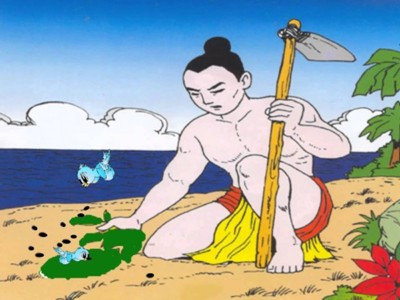 Mai An Tiem and the watermelon
Mai An Tiem and the watermelon
David Lan Pham
 Mai An Tiem and the watermelon
Mai An Tiem and the watermelon
.
Mai An Tiem was tied to the appearance of the watermelon in the Vietnamese people’s minds.
According to the oral tale, Mai An Tiem was from a Southern country. He was sold to King Hung Vuong III as a slave. At that time Champa wasn’t born yet. Mai An Tiem could be a Cham, a Khmer, a Malaysian or an Indonesian.
Malaysia and Indonesia got in touch with the Hindu traders in the 2nd century AD. They were Brahmans before converting to Islam in the 13th century AD. So were the Cham.
Mai An Tiem was intelligent, active and sociable. He learned to speak fluent Vietnamese in a short time. He was trusted by King Hung Vuong III, who gave him and his wife a lot of favor. Mai An Tiem enjoyed princely life. Some officials were jealous of him. They tried to discredit him and to separate him from the King.
One day, a courtier told the King that Mai An Tiem was insolent and unthankful to the King when saying all the comforts he has belonged to him in his past life. The King was very angry. He asked his courtiers how to punish Mai An Tiem.
Death penalty?
Life in prison?
Banishment?
King Hung Vuong agreed to banish Mai An Tiem and his wife to an unpopulated island in Nga Son district, Thanh Hoa province. Mai An Tiem and his wife lived a miserable life on the island.
Suddenly a bird spread some seeds which grew into vines bearing big fruits. Those were vines of watermelon. Mai An Tiem enlarged the plantation of watermelons. He sold them to the Chinese traders in exchange for rice, fresh water, salted fish, Chinese silk etc. He got richer and richer. The Chinese liked watermelons very much. They ate them and said: “Hau! Hau!” (edible; good). From ‘Hau’ in Cantonese the Vietnamese called them Dua Hau (dua: melon) or Tay Qua based on Xigua in Mandarin (melon from the West).
At present Mai An Tiem Festival is celebrated annually on the 11th day of the Third Month of the Lunar Calendar in Nga Phu village, Nga Son district, Thanh Hoa province.
****
The Hong Bang Dynasty (2879- 258 BC) consisted of 18 Kings Hung Vuong. In this period of time Vietnam wasn’t under Chinese rule yet. According to the oral tale, Mai An Tiem sold watermelons to the Chinese traders.
It was written in history the Chinese knew watermelons in the 10th century AD. They were right to call the watermelon Xigua (Tay Qua) which means the melon from the West.
The watermelons (scientific name: Citrulus vulgaris Family: Cucurbitaceae) were originated from the Kalahari Desert, Botswana, Africa. Watermelon seeds were found in the Tomb of Tutankhamon in Egypt (14th century BC).
To China and Vietnam Africa is in the West. For that reason the Chinese call watermelons Xigua. The Vietnamese call them Tay Qua phoneticized from Xigua.
Do you believe Mai An Tiem sold watermelons to the Chinese traders tens of centuries before the latter knew watermelons in the 10th century? The Hindus grew watermelons in the 7th century AD.
The strange thing was that Mai An Tiem sold watermelons to the Chinese traders without knowing the name of the items he sold. The seller named them DUA HAU or TAY QUA phoneticized from Cantonese HAU or from Mandarin XIGUA used by the Chinese traders!
.
David Lan Pham, F.A.B.I.